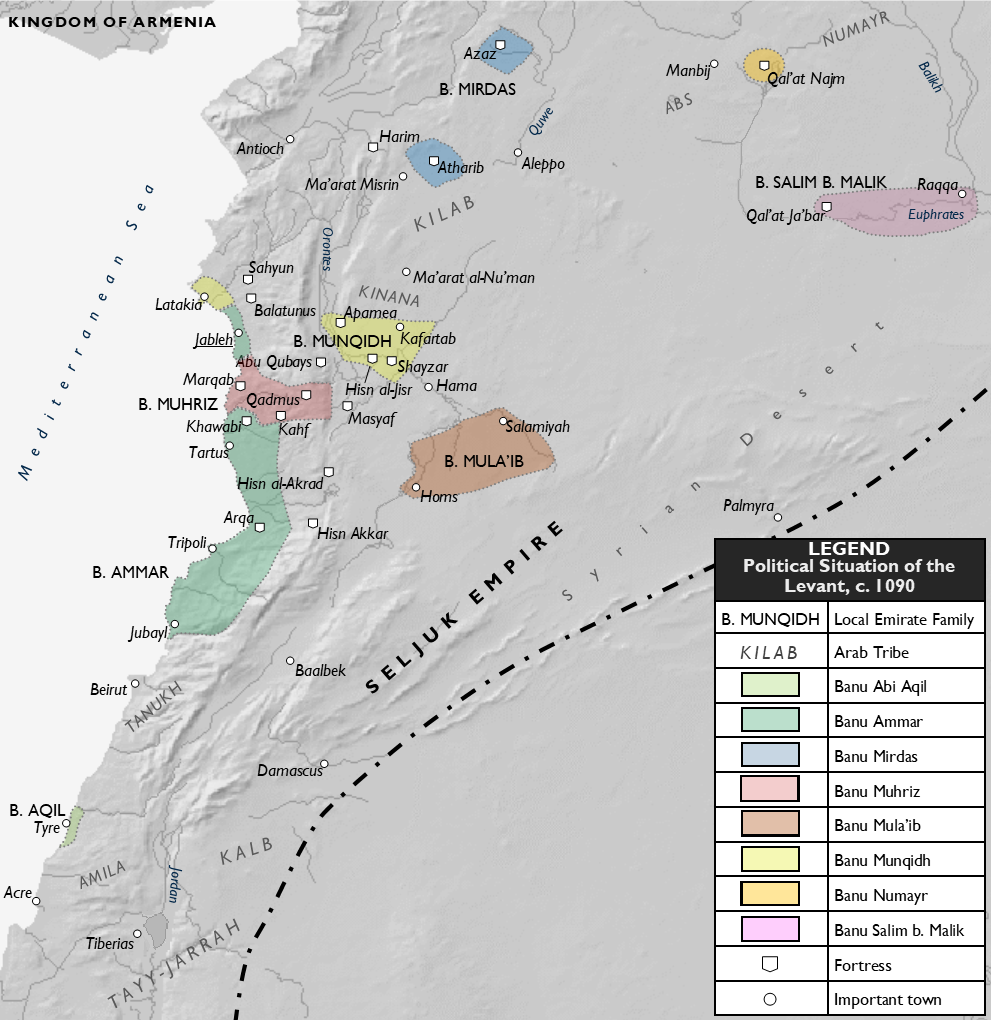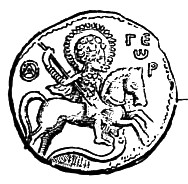|
Banu Muhriz
The Banu Muhriz were an Arab princely family that controlled the fortresses of Marqab (Margat), Kahf and Qadmus in the late 11th and early 12th centuries. The family is credited by a 13th-century Alawite treatise for patronizing the budding Alawite community in the southern Syrian Coastal Mountain Range, along with two other local families, the Banu'l-Ahmar and Banu'l-Arid. The former controlled the Balatunus (Mahalibeh) fortress until losing it to the Byzantines in 1031, while the latter were based in the mountains west of Homs. A member of the Banu Muhriz, the emir of Qadmus Abdallah ibn Ja'far ibn Muhriz, hosted the prominent Alawite missionary Abu'l-Khayr Ahmad ibn Salama al-Hadda (died 1065) in the fortress. An 11th-century poem by an Alawite religious figure celebrated the family. Alawite religious literature notes that another member of the family, the emir Nasih al-Dawla Jaysh ibn Muhammad ibn Muhriz, was a prominent Alawite scholar. The Banu Muhriz lost control of Mar ... [...More Info...] [...Related Items...] OR: [Wikipedia] [Google] [Baidu] |
Political Map Of The Levant, Circa 1085
Politics (from , ) is the set of activities that are associated with Decision-making, making decisions in Social group, groups, or other forms of Power (social and political), power relations among individuals, such as the distribution of resources or Social status, status. The branch of social science that studies politics and government is referred to as political science. It may be used positively in the context of a "political solution" which is compromising and nonviolent, or descriptively as "the art or science of government", but also often carries a negative connotation.. The concept has been defined in various ways, and different approaches have fundamentally differing views on whether it should be used extensively or limitedly, empirically or normatively, and on whether conflict or co-operation is more essential to it. A variety of methods are deployed in politics, which include promoting one's own political views among people, negotiation with other political subje ... [...More Info...] [...Related Items...] OR: [Wikipedia] [Google] [Baidu] |
Jableh
) , settlement_type = City , motto = , image_skyline = Jableh Collage.jpg , imagesize = 250px , image_caption = General view of city and port • Roman Amphitheater• Al-Baath Stadium • Entrance of Roman Theater• Landscape of Jableh • Port , image_flag = , flag_size = , image_seal = , seal_size = , image_shield = , shield_size = , image_blank_emblem = , blank_emblem_type = , blank_emblem_size = , image_map = , mapsize = , map_caption = , image_map1 = , mapsize1 = , map_caption1 = , image_dot_map = , dot_mapsize = , dot_map_caption = , dot_x = , dot_y = , pushpin_map = Syria#Mediter ... [...More Info...] [...Related Items...] OR: [Wikipedia] [Google] [Baidu] |
History Of The Alawites
The Alawis, Alawites ( ar, علوية ''Alawīyah''), or pejoratively Nusayris ( ar, نصيرية ''Nuṣayrīyah'') are an ethnoreligious group that lives primarily in Levant and follows Alawism, a sect of Islam that originated from Shia Islam. The Alawites revere Ali (Ali ibn Abi Talib), considered the Imamate in Shia doctrine, first Imam of the Twelver Schools of Islamic theology, school. The group is believed to have been founded by Ibn Nusayr during the 9th century. Ibn Nusayr was a disciple of the tenth Twelver Imam, Ali al-Hadi and of the eleventh Twelver Imam, Hasan al-Askari. For this reason, Alawites are also called ''Nusayris''. Surveys suggest Alawites represent an important portion of the Syrians, Syrian population and are a significant minority in the Hatay Province of Turkey and northern Lebanon. There is also a population living in the village of Ghajar in the Golan Heights. Alawites form the dominant religious group on the Syrian coast and towns near the coast ... [...More Info...] [...Related Items...] OR: [Wikipedia] [Google] [Baidu] |
Nizari Isma'ili State
The Nizari state (the Alamut state) was a Shia Nizari Ismaili state founded by Hassan-i Sabbah after he took control of the Alamut Castle in 1090 AD, which marked the beginning of an era of Ismailism known as the "Alamut period". Their people were also known as the ''Assassins'' or ''Hashashins''. The state consisted of a nexus of strongholds throughout Persia and Syria, with their territories being surrounded by huge swathes of hostile territory. It was formed as a result of a religious and political movement of the minority Nizari sect supported by the anti-Seljuk population. Being heavily outnumbered, the Nizaris resisted adversaries by employing strategic, self-sufficient fortresses and the use of unconventional tactics, notably assassination of important adversaries and psychological warfare. Despite being occupied with survival in their hostile environment, the Ismailis in this period developed a sophisticated outlook and literary tradition. Almost two centuries after i ... [...More Info...] [...Related Items...] OR: [Wikipedia] [Google] [Baidu] |
Bohemond II Of Antioch
Bohemond II (1107/1108 – February 1130) was Prince of Taranto from 1111 to 1128 and Prince of Antioch from 1111/1119 to 1130. He was the son of Bohemond I of Antioch, Bohemond I, who in 1108 was forced to submit to the authority of the Byzantine Empire in the Treaty of Devol. Three years later, the infant Bohemond inherited the Principality of Taranto under the guardianship of his mother, Constance of France, Princess of Antioch, Constance of France. The Principality of Antioch was administered by his father's nephew, Tancred, Prince of Galilee, Tancred, until 1111. Tancred's cousin, Roger of Salerno, managed the principality from 1111 to 1119. After Roger died in the Battle of the Field of Blood, Baldwin II of Jerusalem took over the administration of Antioch. However, he did acknowledge Bohemond's right to personally rule the principality upon reaching the age of majority. Bohemond came to Antioch in autumn 1126. He launched successful military campaigns against the nearby Mus ... [...More Info...] [...Related Items...] OR: [Wikipedia] [Google] [Baidu] |
Maniqa
Maniqa ( ar, المنيقة) is a castle located in the Syrian Coastal Mountain Range, dated back to the Roman era, it was also known as "Malikas" or "Malghanes" during the Crusader rule. History In 1028, Byzantine doux of Antioch Michael Spondyles was tricked by the Arab tribal leader Nasr ibn Musharraf al-Rawadifi to construct a fortress at Maniqa from where he would defend the Byzantine domains. Michael agreed and even sent a 1,000-strong garrison there, but when the fortress was finished, Nasr refused to hand it over, and with assistance from the qadi of Tripoli and the local Fatimid commander, he killed the garrison. In 1030, Byzantine Emperor Romanos III Argyros ordered Niketas of Mistheia, doux of Antioch, to recapture Maniqa from al-Rawadifi. Niketas managed to control the fort in 1031 after a 13-day siege, in which he also captured Nasr's wife and four daughters, who were abandoned to their fate.John Skylitzes, ''Synopsis of Histories'', 383.91–93 Niketas then secur ... [...More Info...] [...Related Items...] OR: [Wikipedia] [Google] [Baidu] |
Rainald I Masoir
Rainald I Masoir, also known as Renaud I Masoir (died around 1135), was constable of the Principality of Antioch from around 1126, and also baillif (or governor) of the principality from 1132. Although he was a prominent military commander and held important offices, most details of his life are unknown. He received his first estates in the southern regions of Antioch in the 1110s. He made the strong fortress of Margat the center of his domains. He regularly witnessed the Antiochene rulers' diplomas from the 1120s. He was most probably still the actual ruler of the principality when he died. Early career Rainald's origins and family are unknown, but he was most probably born in France. He may have received the fortress of Baniyas (near Jabala) shortly after it was captured by Antiochene troops in May 1109, according to historian Thomas Asbridge. Rainald persuaded the commander of Margat to surrender the fortress to him, along with the nearby forts Maniqa, Qulay'ah and Hadid ... [...More Info...] [...Related Items...] OR: [Wikipedia] [Google] [Baidu] |
Baniyas
Baniyas ( ar, بَانِيَاس ') is a Mediterranean coastal city in Tartous Governorate, northwestern Syria, located south of Latakia (ancient Laodicea) and north of Tartous (ancient Tortosa). It is known for its citrus fruit orchards and its export of wood. North of the city is an oil refinery, one of the largest in Syria, and a power station. The oil refinery is connected with Iraq with Kirkuk–Baniyas pipeline (now defunct). On a nearby hill stands the Crusader castle of Margat (Qalaat el-Marqab), a huge Knights Hospitaller fortress built with black basalt stone. History In Phoenician and Hellenistic times, it was an important seaport. Some have identified it with the Hellenistic city of Leucas (from colonists from the island Lefkada), in Greece, mentioned by Stephanus of Byzantium. It was a colony of Aradus, Strabo, ''Geographica'', 16.2.12Greek sourcean and was placed by Stephanus in the late Roman province of Phoenicia, though it belonged rather to the provinc ... [...More Info...] [...Related Items...] OR: [Wikipedia] [Google] [Baidu] |
Raphanea
Raphanea or Raphaneae ( grc, Ῥαφάνεια; ar, الرفنية, al-Rafaniyya; colloquial: ''Rafniye'') was a city of the late Roman province of Syria Secunda. Its bishopric was a suffragan of Apamea. History Josephus mentions Raphanea in connection with a river Σαββατικον, referred now to as Sambatiyon that flowed only every seventh days (probably an intermittent spring now called Fuwar ed-Deir) and that was viewed by Titus on his way northward from Berytus after the destruction of Jerusalem in AD 70. Near Emesa, Raphanea was the fortified headquarters of the Legio III Gallica from which was launched the successful bid of 14-year-old Elagabalus to become Roman Emperor in 218. Raphanea issued coins under Elagabalus, and many of its coins are extant. Hierocles and Georgius Cyprius mention Raphanea among the towns of Syria Secunda. The crusaders passed through it at the end of 1099; it was taken by Baldwin I and was given to the Count of Tripoli. It was then ... [...More Info...] [...Related Items...] OR: [Wikipedia] [Google] [Baidu] |
Hama
, timezone = EET , utc_offset = +2 , timezone_DST = EEST , utc_offset_DST = +3 , postal_code_type = , postal_code = , area_code = Country code: 963 City code: 33 , geocode = C2987 , blank_name = Climate , blank_info = BSk , website = , footnotes = , name = Hama ( ar, حَمَاة ', ; syr, ܚܡܬ, ħ(ə)mɑθ, lit=fortress; Biblical Hebrew: ''Ḥamāṯ'') is a city on the banks of the Orontes River in west-central Syria. It is located north of Damascus and north of Homs. It is the provincial capital of the Hama Governorate. With a population of 854,000 (2009 census), Hama is the fourth-largest city in Syria after Damascus, Aleppo and Homs. The city is renowned for its sev ... [...More Info...] [...Related Items...] OR: [Wikipedia] [Google] [Baidu] |
Roger Of Salerno
Roger of Salerno (or Roger of the Principate) (died June 28, 1119) was regent of the Principality of Antioch from 1112 to 1119. He was the son of Richard of the Principate and the 2nd cousin of Tancred, Prince of Galilee, both participants on the First Crusade. He became regent of Antioch when Tancred died in 1112; the actual prince, Bohemund II, was still a child. Like Tancred, Roger was almost constantly at war with the nearby Muslim states such as Aleppo. In 1114 there was an earthquake that destroyed many of the fortifications of the principality, and Roger took great care to rebuild them, especially those near the frontier. Roger defeated Bursuq ibn Bursuq in 1115 at the Battle of Tell Danith. With Joscelin I of Edessa, Roger put enough military pressure on Aleppo that the city allied with Ortoqid emir Ilghazi in 1118. Ilghazi invaded the Principality in 1119, and despite the urging of the Patriarch, Roger did not wait for reinforcements from Jerusalem or Tripoli. At the ... [...More Info...] [...Related Items...] OR: [Wikipedia] [Google] [Baidu] |






